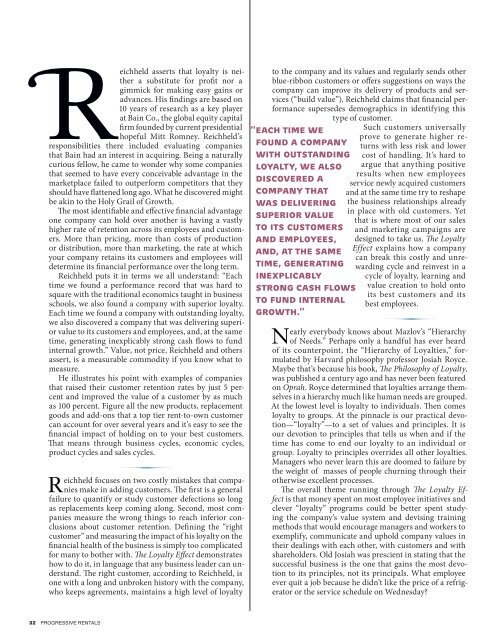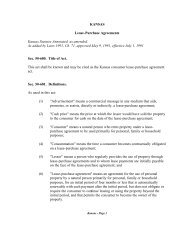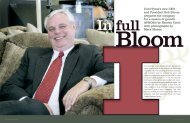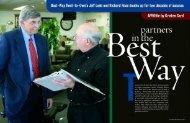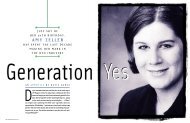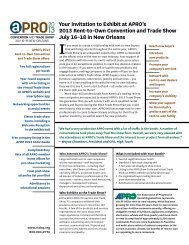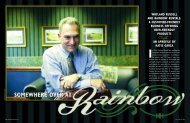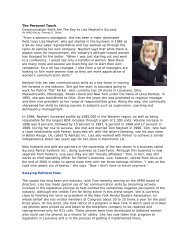Hiring - APRO
Hiring - APRO
Hiring - APRO
- No tags were found...
Create successful ePaper yourself
Turn your PDF publications into a flip-book with our unique Google optimized e-Paper software.
Reichheld asserts that loyalty is neithera substitute for profit nor agimmick for making easy gains oradvances. His findings are based on10 years of research as a key playerat Bain Co., the global equity capitalfirm founded by current presidentialhopeful Mitt Romney. Reichheld’sresponsibilities there included evaluating companiesthat Bain had an interest in acquiring. Being a naturallycurious fellow, he came to wonder why some companiesthat seemed to have every conceivable advantage in themarketplace failed to outperform competitors that theyshould have flattened long ago. What he discovered mightbe akin to the Holy Grail of Growth.The most identifiable and effective financial advantageone company can hold over another is having a vastlyhigher rate of retention across its employees and customers.More than pricing, more than costs of productionor distribution, more than marketing, the rate at whichyour company retains its customers and employees willdetermine its financial performance over the long term.Reichheld puts it in terms we all understand: “Eachtime we found a performance record that was hard tosquare with the traditional economics taught in businessschools, we also found a company with superior loyalty.Each time we found a company with outstanding loyalty,we also discovered a company that was delivering superiorvalue to its customers and employees, and, at the sametime, generating inexplicably strong cash flows to fundinternal growth.” Value, not price, Reichheld and othersassert, is a measurable commodity if you know what tomeasure.He illustrates his point with examples of companiesthat raised their customer retention rates by just 5 percentand improved the value of a customer by as muchas 100 percent. Figure all the new products, replacementgoods and add-ons that a top tier rent-to-own customercan account for over several years and it’s easy to see thefinancial impact of holding on to your best customers.That means through business cycles, economic cycles,product cycles and sales cycles.∂Reichheld focuses on two costly mistakes that companiesmake in adding customers. The first is a generalfailure to quantify or study customer defections so longas replacements keep coming along. Second, most companiesmeasure the wrong things to reach inferior conclusionsabout customer retention. Defining the “rightcustomer” and measuring the impact of his loyalty on thefinancial health of the business is simply too complicatedfor many to bother with. The Loyalty Effect demonstrateshow to do it, in language that any business leader can understand.The right customer, according to Reichheld, isone with a long and unbroken history with the company,who keeps agreements, maintains a high level of loyaltyto the company and its values and regularly sends otherblue-ribbon customers or offers suggestions on ways thecompany can improve its delivery of products and services(“build value”). Reichheld claims that financial performancesupersedes demographics in identifying thistype of customer.Such customers universallyprove to generate higher returnswith less risk and lowercost of handling. It’s hard toargue that anything positiveresults when new employeesservice newly acquired customersand at the same time try to reshapethe business relationships alreadyin place with old customers. Yetthat is where most of our salesand marketing campaigns aredesigned to take us. The LoyaltyEffect explains how a companycan break this costly and unrewardingcycle and reinvest in acycle of loyalty, learning andvalue creation to hold ontoits best customers and itsbest employees.∂Nearly everybody knows about Mazlov’s “Hierarchyof Needs.” Perhaps only a handful has ever heardof its counterpoint, the “Hierarchy of Loyalties,” formulatedby Harvard philosophy professor Josiah Royce.Maybe that’s because his book, The Philosophy of Loyalty,was published a century ago and has never been featuredon Oprah. Royce determined that loyalties arrange themselvesin a hierarchy much like human needs are grouped.At the lowest level is loyalty to individuals. Then comesloyalty to groups. At the pinnacle is our practical devotion—“loyalty”—toa set of values and principles. It isour devotion to principles that tells us when and if thetime has come to end our loyalty to an individual orgroup. Loyalty to principles overrides all other loyalties.Managers who never learn this are doomed to failure bythe weight of masses of people churning through theirotherwise excellent processes.The overall theme running through The Loyalty Effectis that money spent on most employee initiatives andclever “loyalty” programs could be better spent studyingthe company’s value system and devising trainingmethods that would encourage managers and workers toexemplify, communicate and uphold company values intheir dealings with each other, with customers and withshareholders. Old Josiah was prescient in stating that thesuccessful business is the one that gains the most devotionto its principles, not its principals. What employeeever quit a job because he didn’t like the price of a refrigeratoror the service schedule on Wednesday?32 PROGRESSIVE RENTALS


